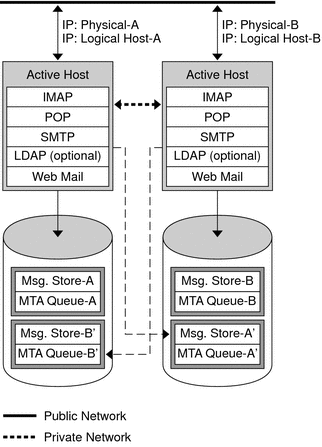3.2.2 Symmetric
The basic symmetric or "dual services" high availability model consists of two hosting machines, each with its own logical IP address. Each logical node is associated with one physical node, and each physical node controls one disk array with two storage volumes. One volume is used for its local message store partitions and MTA queues, and the other is a mirror image of its partner's message store partitions and MTA queues.
The following figure shows the symmetric high availability mode. Both nodes are active concurrently, and each node serves as a backup node for the other. Under normal conditions, each node runs only one instance of Messaging Server.
Figure 3–2 Symmetric High Availability Mode

Upon failover, the services on the failing node are shut down and restarted on the backup node. At this point, the backup node is running Messaging Server for both nodes and is managing two separate volumes.
The advantage of this model is that both nodes are active simultaneously, thus fully utilizing machine resources. However, during a failure, the backup node will have more resource contention as it runs services for Messaging Server from both nodes. Therefore, you should repair the failed node as quickly as possible and switch the servers back to their dual services state.
This model also provides a backup storage array. In the event of a disk array failure, its redundant image can be picked up by the service on its backup node.
To configure a symmetric model, you need to install shared binaries on your shared disk. Note that doing so might prevent you from performing rolling upgrades, a feature that enables you to update your system during Messaging Server patch releases. (This feature is planned for future releases.)
- © 2010, Oracle Corporation and/or its affiliates
